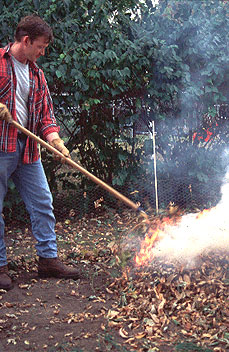For questions or concerns about open burning, please contact the DNR Field Office for your area.
Regulations and Instructions
Education and Outreach
Leaf Burning
 Smoke from burning leaves, grass, brush, and most plants contain high concentrations of pollutants, such as carbon monoxide, particulate matter (soot), toxic chemicals, and reactive gasses that can contribute to smog formation.
Smoke from burning leaves, grass, brush, and most plants contain high concentrations of pollutants, such as carbon monoxide, particulate matter (soot), toxic chemicals, and reactive gasses that can contribute to smog formation.
The smoke can be an immediate health concern for some people. Pollution levels adjacent burn areas can exceed human health standards.
What's in Leaf Smoke?
Carbon monoxide binds with hemoglobin in the bloodstream to reduce oxygen flow. Carbon monoxide can be dangerous for young children, smokers, the elderly, and people with chronic heart or lung disease.
Particulate matter refers to microscopic soot particles. Too small to be seen individually with the unaided eye, dense concentrations are visible as smoke. These particles are less than 2.5 microns in size -- roughly the thickness of a human red blood cell. They can become embedded in lung tissue and are known to contribute to premature death, affect persons with heart conditions and trigger asthmatic reactions for some people.
Hazardous chemicals; Benz(a)pyrene is known to cause cancer in animals and is believed to be a factor in lung cancer caused by smoking. It is present in leaf smoke.
Please learn not to burn. Composting, mulching and bagging are cleaner options.
Garbage/Trash Burning
 'Backyard burning' of common household trash and garbage emits substantial amounts of poisons and toxins into our environment. The smoke is a known health and environmental hazard. EPA emission tests show one burn barrel emits up to 80 times more pollution and up to 11 times the dioxin per pound of garbage burned than a municipal waste incinerator that serves tens of thousands of homes. Residential trash burning is now the nation’s largest source of dioxin emissions.
'Backyard burning' of common household trash and garbage emits substantial amounts of poisons and toxins into our environment. The smoke is a known health and environmental hazard. EPA emission tests show one burn barrel emits up to 80 times more pollution and up to 11 times the dioxin per pound of garbage burned than a municipal waste incinerator that serves tens of thousands of homes. Residential trash burning is now the nation’s largest source of dioxin emissions.
State rules prohibit burning items that can be locally recycled. Common household trash such as synthetics, plastics, metals, and packaging release potent chemicals when burned. Even common paper products such as junk mail, cardboard, newsprint, and magazines contain chemical dyes, coatings, pigments and chlorine.
Emissions include particulate matter, carbon monoxide, acids and toxins such as vinyl chloride, heavy metals, dioxins and furans to name a few. Inhalation may cause immediate irritation or asthmatic attack. Exposure increases the long-term health risks for respiratory problems, cancers, birth defects, developmental abnormalities and other serious health problems for burners and persons downwind. These may occur many years after exposure.
Several toxic chemical emitted are PBTs--Persistent, Bioaccumulative Toxins. They take many decades to breakdown and are building up in the environment and some food chains, posing additional risks when consumed. PBTs are a national pollutant of concern.
Burning household trash in piles, barrels and pits is a poor combustion method with low temperatures, poor oxygen flow and lack of emission controls unlike municipal incinerators. Please learn not to burn. Sanitary disposal and recycling are safe, clean and convenient options. For materials, contacts and resources for cleaner disposal, check out the
Iowa DNR Waste Management website.
You can help keep poison out of our air, food, water and soil by finding cleaner waste disposal options and using alternatives to burning.